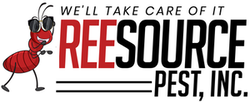We are going to focus on two main species of crickets that are most common in structures and homes. Their common names are, Camel/Cave crickets and Field crickets:
Camel crickets
The Camel Cricket has many names people call them such as “Sprickets”, “Spider crickets” and so on. Many people are pretty creeped out by them but they are harmless.
These guys develop by incomplete metamorphosis. Females will lay their eggs in the early spring and by April those will hatch. They average around 1/2″-1″ in size as adults. They’re most active during the nighttime hours. They prefer cool moist areas such as basements, utility rooms, garages, and crawl spaces. They feed on a wide variety of things outside on mostly decaying organic debris such as leaf piles, brush piles, and the like. They’ve been known to feed on plant stems. Inside the structure or home, these crickets have been known to feed on paper items and different types of fabric. Not much is known about their biology. Good control of these crickets can be obtained by removing items piled against the side of the structure such as leaf piles, grass clipping piles, woodpiles, etc. Granular insecticide baits work very well at controlling outside populations around a structure.
A professional pest control tech may elect to use a liquid residual spray in the affected areas. Inside the home, if there’s a crawl space with moisture issues and continuous issues with Camel crickets, then the crawl space should be enclosed using a poly/vapor barrier and then installing a commercial-grade hardwired dehumidifier. In basements and garages – a dehumidifier (a stand-alone version most commonly used in homes) is recommended if those areas are continuously damp. You can also check with your HVAC company to see about installing dehumidifiers in line with the unit. Sealing off gaps and holes 1/8″ or bigger on the exterior of the home using caulk is recommended to keep these critters out. More importantly, doors with gaps at the bottoms larger than 1/8″ should be excluded by installing a bristle type door sweep at the bottom.
Field crickets
These crickets are brown-colored insects with wings (they do not fly very well or at all). They range in size from 1/2″ to 1″ long and they develop by incomplete metamorphosis.
Outside – they are a voracious feeder of crops in farmland areas and in gardens planted outside. They also feed on other insects and will sometimes feed on other field crickets. Field crickets will overwinter in the egg stage until spring when they emerge out of the soil as nymphs. The female can lay between 150-400 eggs. They become mature around 80-90 days after hatching. There can be up to three generations in a year. On the exterior of a structure or home, crickets will most likely be found in moist areas such as in leaf piles or woodpiles, around stones, and the like.
Mowing your lawn and keeping the grass trimmed down helps control field crickets. Crickets are mostly nocturnal and are attracted heavily to lights outside at night. If a homeowner/property owner has lighting on the exterior at night – sodium vapor lighting is best as it’s less attractive to them. Inside the structure or home, field crickets do not survive a long time. They can feed on and damage different fabrics such as wool, linen, silk, synthetics, and other different types of fabric. Granular insecticide baits are an excellent choice to control field crickets. Glue traps are effective in removing numbers of crickets indoors.
A professional pest control tech may elect to use a residual liquid or aerosol insecticide to control them where they’re problematic. Outside, they’d do the same and should apply a band of granular insecticide around the home or structure.
